
The difference between raw and ripe Pu-erh is the respective fermentation processes that each type of tea undergoes. Raw Pu-erh is made from fresh leaves undergoing basic steps of tea processing and then left to age naturally over time. Ripe Pu-erh is made from Mao Cha undergoing a controlled post-fermentation process called “wo dui.” This speeds up the aging progress and causes the resulting tea to mimic the taste profile of an aged raw Pu-erh without having the tea undergoes the much longer time required for natural aging. Below are pictorial essays on the steps involved with making raw and ripe Pu-erh teas.
MAKING RAW PU-ERH
From tree to primary tea.

The picking of fresh leaves

Quickly transporting the fresh leaves to the processing center
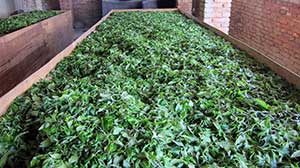
Indoor withering the leaves to soften and dehydrate them
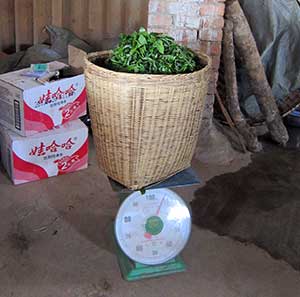
Weighing the fresh leaves
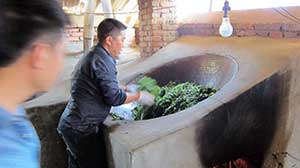
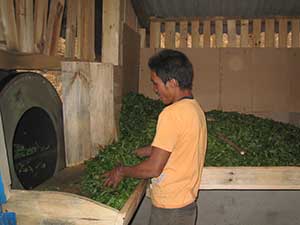
Stir-frying the leaves in a wok by hand or in a drying machine to deactivate the enzymes within the leaves, a process called "killing green"
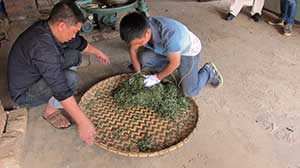
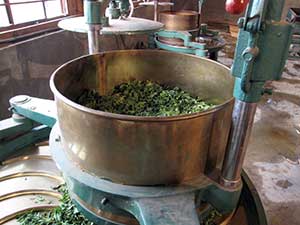
Kneading and rolling the leaves by hand or by machine for shaping and further removing moisture from the leaves


Sun-drying the leaves
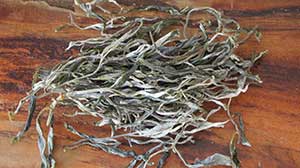
Finally, the leaves are made into "mao cha" (primary tea) that is ready for consumption and sale. The tea can be sold loose, compressed or further made into ripe Pu-erh
Pu-erh is a post-fermented tea. Unlike all other teas where the processing is continuous until it is finished. Pu-erh tea’s processing is divided into two phases. Post-fermentation means that after the tea has first completed its initial processing, the tea then undergoes a fermentation process, either naturally or by manually-induced means.
The manually induced fermentation, a process named "wo-dui" is used by the tea manufacturers in Yunnan to ferment (or "ripen") the loose raw Pu-erh leaves. The purpose for this controlled post-fermentation process is to mimic the flavor profile of the aged raw Pu-erh without having to wait the 20-30 years required for natural fermenation. In addition to quickly achieving the earthy flavor similar to that of aged raw Pu-erh, ripe Pu-erh also offers properties that are not present in any other teas. Dr. Selena Amed, an Ethnobotanist who is a post-doctoral fellow at the Antioxidants Research Lab at the Jean Meyer USDA Human Nutrition Research Center on Aging at Tufts University wrote: "The microorganisms in black (or ripe) Pu-erh oxidize polyphenols more completely than the enzymatic oxidation of other black teas and create fermentation-derived compounds know as statins. Black Pu-erh teas are natural fermentation-derived sources of statins that are found in other natural products such as oyster mushrooms and red yeast rice." To read more on Dr. Ahmed’s studies, please refer to the article and link below.
Pu-erh Tea and the Southwest Silk Road: An Ancient Quest for Well-Being
http://cms.herbalgram.org/herbalgram/issue90/Feat_SilkRoad.html
Most "wo-dui" processing requires one to several tons of tea leaves. The dry leaves are piled on the floor and sprayed with water until the leaves are wet to a certain degree. The pile is then covered with a cloth or blanket and the fermentation process begins with the tea leaves undergoing microbial activity, which causes the temperatue of the tea pile to rise. When the pile heats up to a certain temperature, the pile is turned manually to evenly distribute the temperature of the leaves. This process is repeated several times throughout the fermentation process until the pile reaches the proper degree of fermentation. Subsequently, the pile is removed to another room to dry thoroughly. When the processing is complete, the ripe Pu-erh leaves can be sold as loose leaf tea or they can be compressed into cakes, bricks or other shapes.
Qualities of ripe Pu-erh vary widely. First of all, the tea must start with a good leaf source. Secondly, the skill of the tea master who administers the fermentation process and controls the conditions of the fermentation facility matters a great deal. A poor quality ripe Pu-erh can taste fishy and moldy while a good quality ripe Pu-erh will taste woody, smooth, mellow and sweet. Although the ripe Pu-erh does not offer a dramatic transformation like the raw Pu-erh over time, aged quality ripe Pu-erh will become thicker, smoother and more savory. Common flavor profiles include the flavor of dates, ginseng and dried longan (dragon-eye fruit).
Modern fermentation facilities are constructed with good ventilation and drainage designs. We visited a newly-built fermentation facility where the floor is strategically seasoned with used tea leaves, the ceiling can be opened when the temperature gets too hot inside and the floor has drainage pipes underneath so that excess water from the pile can be drained out. We inspected a sample of tea leaves that were being fermented and the leaves smelled of wine.

A modern fermentation facility we visited in Menghai, Yunnan
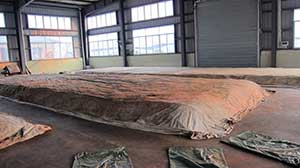
Piles of leaves undergoing fermentation

Windows are installed in the ceiling to circulate the air when the inside temperature is too hot
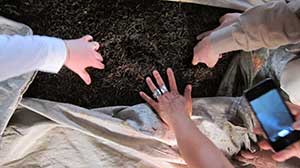
Testing the temperature inside the leaf pile
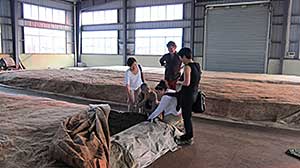
Master Chan examining the fermenting leaf
TASTE PROFILES OF A RAW & RIPE PU-ERH
To learn more about the taste profile of raw Pu-erh teas, click here. To taste Pu-erh teas for yourself, Bana offers a Raw Pu-erh Sampler with of seven of our best raw teas including our very popular Purple Tip and Moonlight White, a Ripe Pu-erh Sampler for an overview of seven premium ripe teas including our best sellers, and a Variety Pu-erh Sampler for an overview of both raw and ripe teas including 3 of our best sellers.

